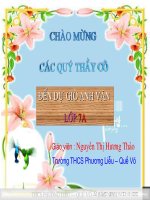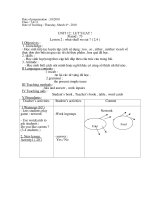Unit 12 Let s eat
Bạn đang xem bản rút gọn của tài liệu. Xem và tải ngay bản đầy đủ của tài liệu tại đây (1.1 MB, 20 trang )
<span class='text_page_counter'>(1)</span>HELLO EVERYONE !!!! Team 3: Gary (Leader) Alexandra (Assistance) Sushi (Supporter) Hoang Anh (Supporter).
<span class='text_page_counter'>(2)</span> Today we are going to tell all of you about Ancient Egypt: Conflicts and Contacts Conquests and Trade.
<span class='text_page_counter'>(3)</span> TRADE - The Nile River was important trade route for the Egyptains, not only to transport goods within Egypt, but to travel distant places. - Another trading route was created when the Egyptians cut a canal through to Nubia. - During later dynasties the Egyptains became skilled ship-builders, which allowed them to trade with countries around the Mediterranean Sea. - Over the years trade relationships were formed with many countries keen to acquire the bountiful food that was grown in Egypt..
<span class='text_page_counter'>(4)</span> TRADE.
<span class='text_page_counter'>(5)</span> MILITARY CONQUESTS The first armies of Ancient Egypt were established to make sure that Egypt did not splinter apart. Later, armies were sent out to acquire land and resources. Egypt benefited from the wealth it accumulated by conquering other nations, and by learning about the battle techniques and weapons of its enemies. For example, the chariot and composite bow were introduced after the Egyptians witnessed their usefulness in battles againts the Hyksos..
<span class='text_page_counter'>(6)</span> MILITARY CONQUESTS The New Kingdom is also known as the Age of Conquests because at the time Egypt became more powerful empire and expanded its territories. Massive armies became common and a powerful navy was created to protect the Nile River. It became common to recruit foreign paid soldiers, known as mercenaries, as they were believed to be more rehable and less open to corruption..
<span class='text_page_counter'>(7)</span> THUTMOSE I Thutmose I, who ruled Egypt from about 1506 to 1493 BCE, is remembered for his military achievements and for establishing ancient Egypt’s first standing army. He fought two important campaigns in Nubia and Syria and he created what became known as the Egyptian Empire. Thutmose I ordered the canal between Egypt and Syria to be built, which gave direct access to many places and increased trade. He is also believed to be the first pharaoh to build fotresses along rivers during the Syria campaign..
<span class='text_page_counter'>(8)</span> THUTMOSE I.
<span class='text_page_counter'>(9)</span> THUTMOSE I BIOGRAPHY DOCUMENTARY.
<span class='text_page_counter'>(10)</span> RAMESES II Rameses II became pharaoh in 1279 BCE and led several military campaigns to Nubia, Libya and Syria.His most important campaign was into Syria in 1274 BCE, where he led his troops to fight in the Battle of Kadesh. Under his rules Egypt became more wealthy and powerful. Rameses II is belived to have created the world’s first peace treaty between himself and the king of the Hittite Empire. This treaty was signed in 1280 BCE after two years of negotiations and ended years of war between the Egyptians and the Hittites..
<span class='text_page_counter'>(11)</span> RAMESES II.
<span class='text_page_counter'>(12)</span> RAMESES II BIOGRAPHY DOCUMENTARY.
<span class='text_page_counter'>(13)</span> THE BATTLE OF KADESH - The battle between the Egyptians and the Hittites at Kadesh – 1274 BCE – was the largest recorded chariot battle in history. In this battle, Rameses split his army into four corps. - Each march 10 kilometres apart, which meant they could not support one another because of distance. - One group, led by Rameses, captured two men who deceived them by saying that the Hittites had fled the city. The Egyptians then went on towards the city but were ambushed and had to retreat from Kadesh under attack. - Rameses sent messengers warning of the trap and his soldiers arrived by boat, fighting.
<span class='text_page_counter'>(14)</span> BATTLE OF KADESH.
<span class='text_page_counter'>(15)</span> QUESTION AND ANSWER.
<span class='text_page_counter'>(16)</span> Q&A #1 1.Using source 8B and 8C in your History Book, make a list of the most commonly traded items: Two pots of fat. Five loincloths made of fine fabric. One dress made of upper Egyptian linen, equals 20 deben. Three hundred asses laden with incense. Heknu. Grain. Panther [skins]. Ivory. Throw sticks and every good product..
<span class='text_page_counter'>(17)</span> Q&A #2 2. Tell us something about the word ‘heknu’ and ‘deben’. Heknu: A type of oil that was used during religious ceremonies in Ancient Egypt. Deben: A unit of weight. From the time of New Kingdom, it was equal to about 90 grams..
<span class='text_page_counter'>(18)</span> Q&A #3 3 (1).Thutmose I ruled what country, from when to when? 3 (1). Thutmose I ruled Egypt from 1506 to 1493 BCE. 4 (2). What were his two important campaigns that he fought and what did he created? 4 (2). He fought two important campaigns in Nubia and Syria, and he created what became known as the Egyptian Empire..
<span class='text_page_counter'>(19)</span> Q&A #4 5 (1). When did Rameses become pharaoh and lead what? 5 (1). Ramese become the Pharaoh in 1279 BCE and led several military campaigns to Nubia, Libya and Syria. 6 (2). What did Rameses II create? 6 (2). Ramese II is believed to have created the world’s first peace treaty between himself and the king of the Hittite Empire..
<span class='text_page_counter'>(20)</span> THANK YOU ALL OF YOU FOR ENJOYING OUR PRESENTATION! - Hope you guys will learn well more at History. - Good luck and have a good day..
<span class='text_page_counter'>(21)</span>









